Rulebooks
The best part of the board gaming hobby is getting to discover games of all different themes, mechanics, styles, player counts, etc. We all have favorite games that we love to pull out every game night, but it’s also tons of fun to get new games and play them too! The not-necessarily-fun part of new games, though, is having to read the rulebook first. Kind of a Jekyll and Hyde in games, a rulebook can either enhance your overall experience of a game, or leave a seriously bad taste in your mouth. What follows are my thoughts on what makes a rulebook effective and accessible!
Overall Layout – First and foremost, the overall layout of the rulebook is so much more important than people think! My favorite rulebooks are the ones that go logically, step-by-step. It might seem obvious, but you’d be surprised… Right on the first page, I love to see a list of game components. Might not seem like a big deal to some people, but as someone who is always anxious about losing components (even though I haven’t yet!), I like to know exactly what is in the box so I can do a quick check if needed. The next logical item is the game setup. Yes, having some flavor text is good and all, but really I’m here to play the game, and that’s what I want to get to. The next logical step is to describe the steps/phases of play in chronological order. Tell me exactly how a turn/round should play out, step-by-step. I dislike when rulebooks jump around because it makes it more difficult to follow logically. If I have to flip between multiple pages of the rulebook to find the necessary information for a seemingly simple aspect of the game, it really grinds my gears. Related information should be kept together, for easy reference and natural flow of the rules. After explaining how to play the game, the rulebook should have a clear section on how to win/final scoring/etc. Some rulebooks put that information towards the beginning, or mention it in passing as part of another turn step, but a dedicated section for the end game is necessary for clear understanding. Finally, while absolutely not necessary for every game, I like when rulebooks have an FAQ section (if applicable) at the end. So ultimately, does the layout of the rulebook make sense? Is it intuitive, clear, and understandable? If yes, awesome – I can’t wait to start playing! If not, then I’m probably starting a little apprehensively, and that can taint my overall experience.
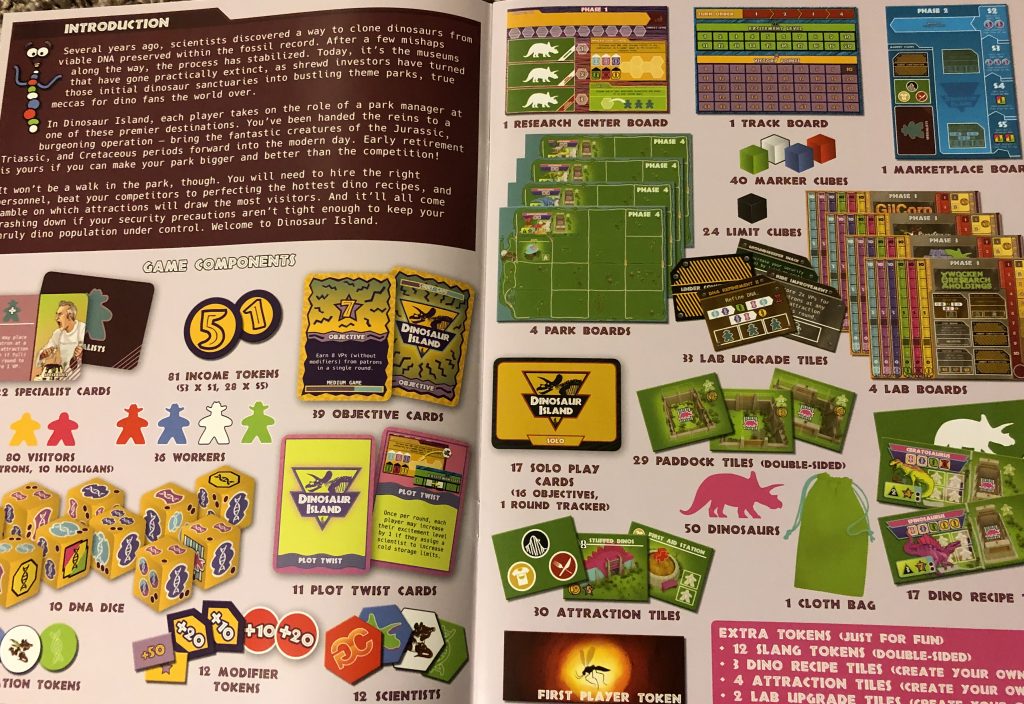
Pictures – A picture is worth 1,000 words, and sometimes in rulebooks a mere written description of something just doesn’t cut it for me. Seeing a picture of the game setup, for example, can make the process soooo much easier because I now have a reference to check and a model I can copy. Instead of just saying, “Put the deck near the play area,” show me where to put it. Does it need to be in reach of all players? Will it need open space near it for revealing cards? Including pictures of components is huge for me. When games have lots of different tokens or cards, simply listing them doesn’t help me figure out what component matches what name. Show me a token face or card back to help me identify what everything is, and that can dramatically increase my understanding when reading the rest of the rulebook. Besides just setup and component pictures, pictures throughout the various turn steps can help alleviate ambiguity or questions remaining after reading the written steps. If one step is particularly complicated, show me how it works, don’t just describe it to me. One of my biggest gripes with bad rulebooks is that they don’t have enough pictures. Visuals are so helpful when learning a new game, and they should be a priority in rulebooks.
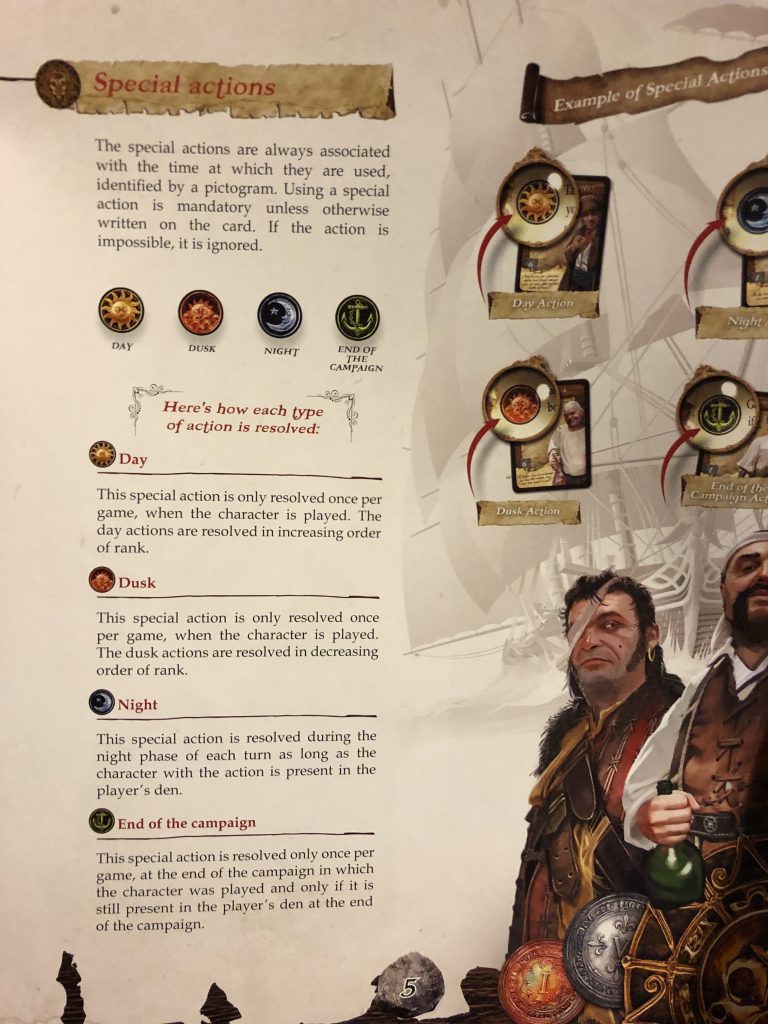
Details – Rulebooks that are extremely descriptive and detailed make my heart happy. Especially when learning a new mechanic, the more in-depth the rule descriptions are, the better! Providing lots of detail can result in fewer rules mistakes/misunderstandings for players. I know the saying is “show, don’t tell,” but why not show AND tell? I would rather have a descriptive and ‘wordy’ rulebook rather than a short and ambiguous one any day. A caveat for my previous statement – as long as the descriptions and details are useful and effective, length of the rulebook is irrelevant to me. If the descriptions are long-winded and don’t actually provide relevant information, they’re frustrating to read and can result in more confusion. The devil really is in the details, and that can make or break the effectiveness of a rulebook.
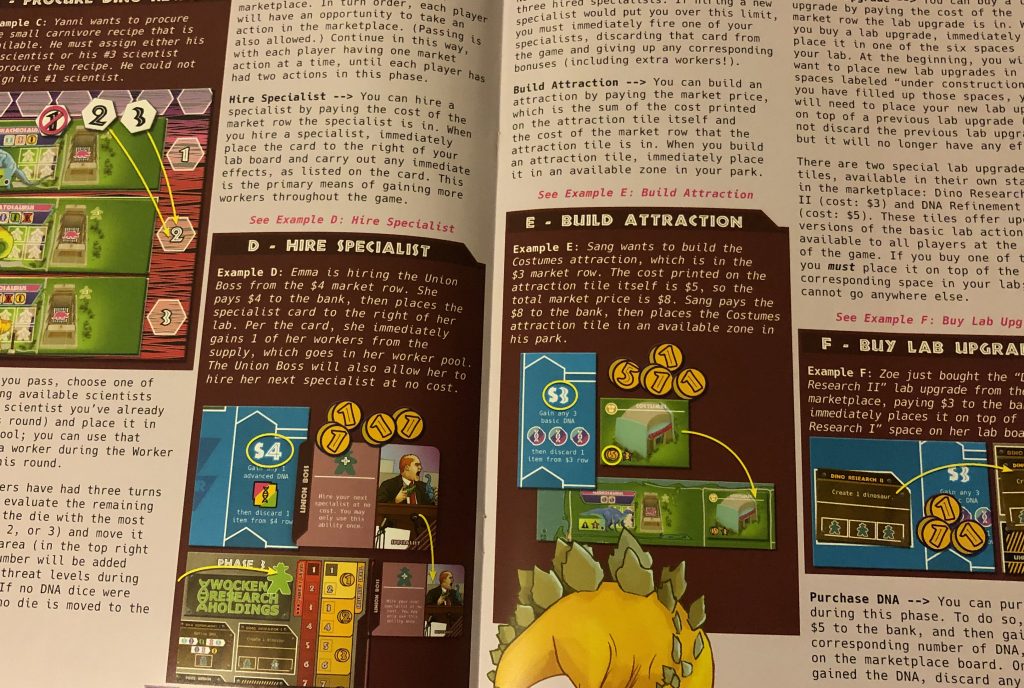
Examples – Going along with providing lots of details, providing example turns throughout the rulebook is also an awesome practice that I wish more people would consider. Getting to see how the turns/movement/scoring/etc. work is a huge help. Instead of just having to imagine how a step is carried out, getting to see and follow along with an example can answer many questions I may have had left from reading the rules alone. I especially like when an example takes you through the entire game so you get to see it from start to finish. It’s a great way to show the players exactly how every turn is played, and how the game is won. I cannot advocate enough for the inclusion of examples in rulebooks – providing multiple methods for understanding are a must since everyone learns differently! I’m letting my teacher-side get into this article, but the same definitely applies to gaming as well.
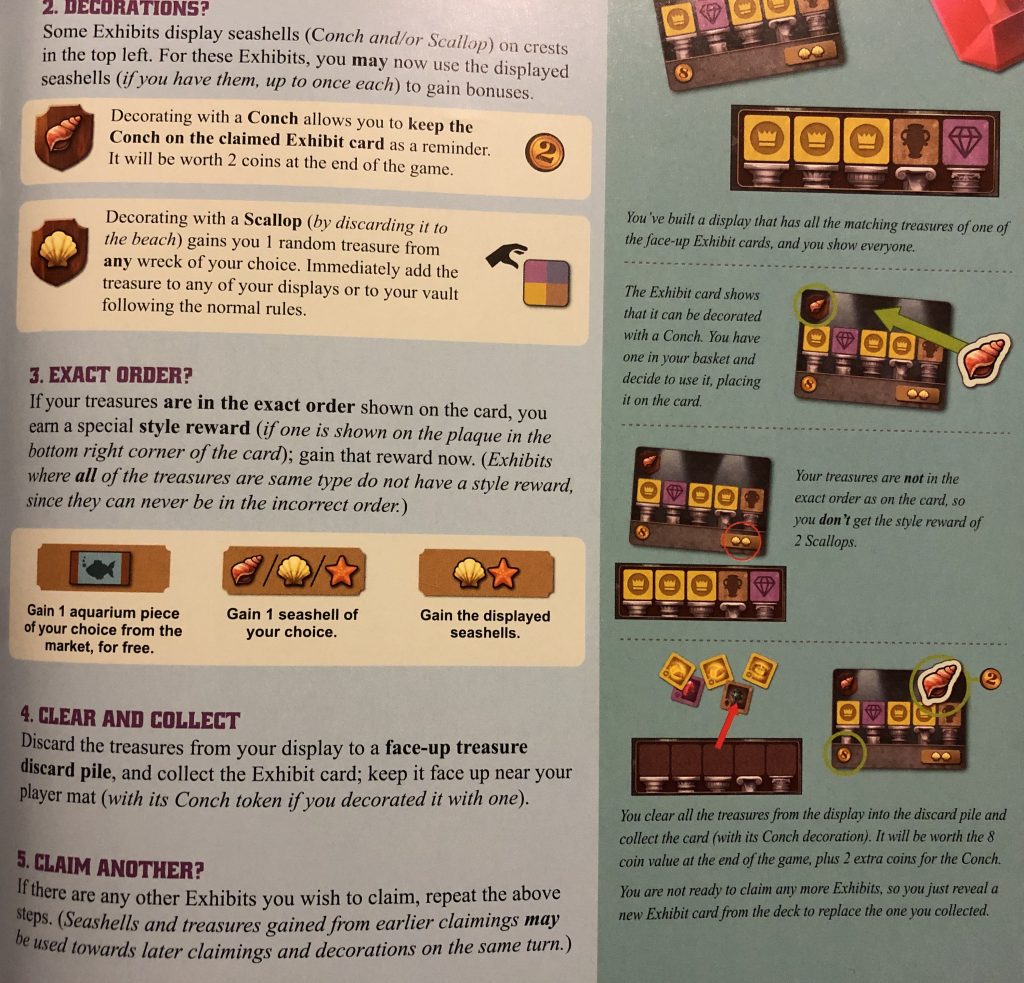
FAQ’s – Not all games need them, but those that provide FAQ’s at the end of the rulebook are a step above the rest for me. It shows that they have thought ahead and considered points of ambiguity or discrepancy and have proactively tried to answer any questions you may have remaining. Most times, if I do still have a question, the answer can be found in the rulebook’s FAQ’s! Like I said, not all rulebooks need an FAQ, but it’s definitely something I like to see in heavier games.
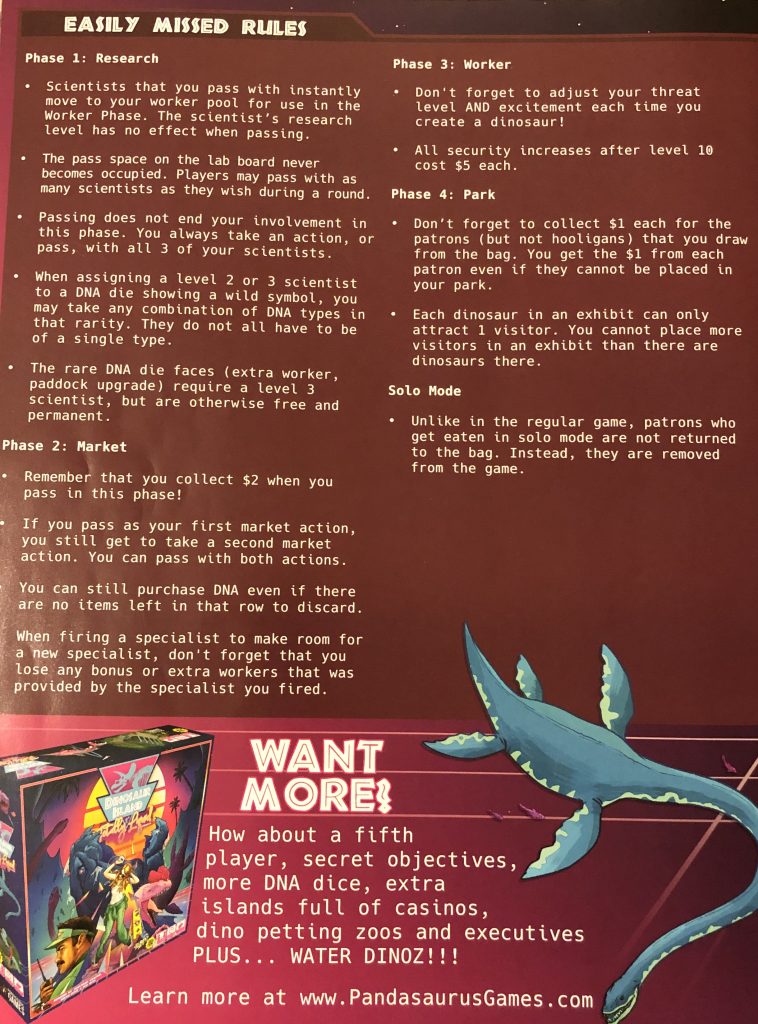
Rulebooks I Love and Why – The first one I want to mention is Dinosaur Island. I don’t think I’ve ever read a rulebook that I love more than this one. The overall layout is great – logical and easy to follow. The next best thing? There are pictures, details, and examples galore! Nearly everything is thoroughly described through text and pictures. I was able to play Dinosaur Island after merely one reading of the rulebook, and I feel like for such a complex game, that’s really saying something. Perhaps one of the coolest parts of this rulebook for me is the last page – Easily Missed Rules. Not a simple FAQ, but a reiteration of important aspects of the phases that are often missed during play. It’s a great reference to have on hand throughout the game. This is by no means a short rulebook, but the way the information is presented and described makes its length worthwhile. Dinosaur Island is a great game, and it’s made even greater by its well-executed rulebook. Century: Golem Edition is kind of on the complete opposite side of the spectrum from Dinosaur Island, but its rules are still as effective. Overall, this is a lighter game, and the rules reflect that. Presented on a front-and-back sheet, the layout is logical and concise. The text is simple and understandable, and includes relevant pictures and examples when detailing turns. To me, this is a perfect example to show that rules can be both concise and effective – those two things are not mutually exclusive!
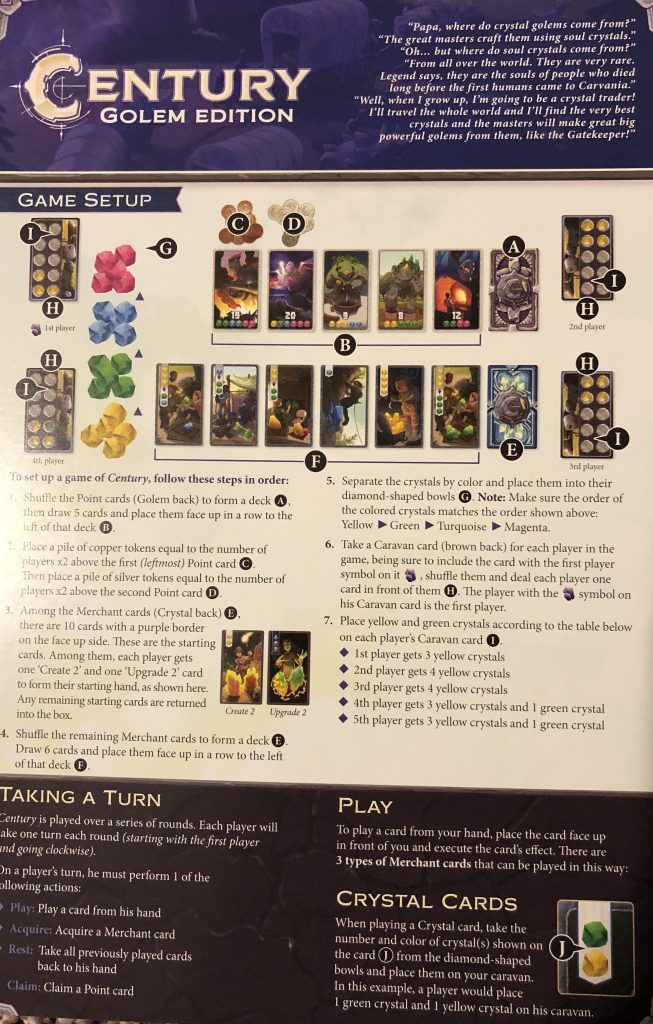
Rulebooks I DON’T Love and Why – Perhaps my least favorite rulebook ever is the one for The Oregon Trail Card Game. This is supposed to be a light card game, reminiscent of the original computer game, and the rules try to reflect that simplicity. Unfortunately, I think it backfires big time. The most frustrating part of this rulebook for me is probably the layout. It’s more of a brochure than a book, which can be fine if executed well. All rules are essentially just laid out in a numerical list, with no real distinction between sections like turn order, card abilities, special circumstances, etc. The text itself is also pretty ambiguous, and I swear I have played this game differently every time because of new interpretations of the rules. One positive of this rulebook is that it does have several graphics for examples, so that’s a plus. Overall though, not a rulebook I’d ever want to read again. Another rulebook that I had a hard time with is that of Firefly: Shiny Dice. Opposite of Oregon Trail, this is an actual rulebook with lots of pages detailing the game. Same as with Oregon Trail, though, the text is pretty ambiguous and difficult to understand. This rulebook really does not have any pictures or examples, which also made my overall comprehension suffer. Without being able to see how certain turn steps play out, or how certain cards/dice can be used, I kind of was just left guessing. This rulebook certainly has a lot of text, but the text is ineffective at fulfilling its purpose.
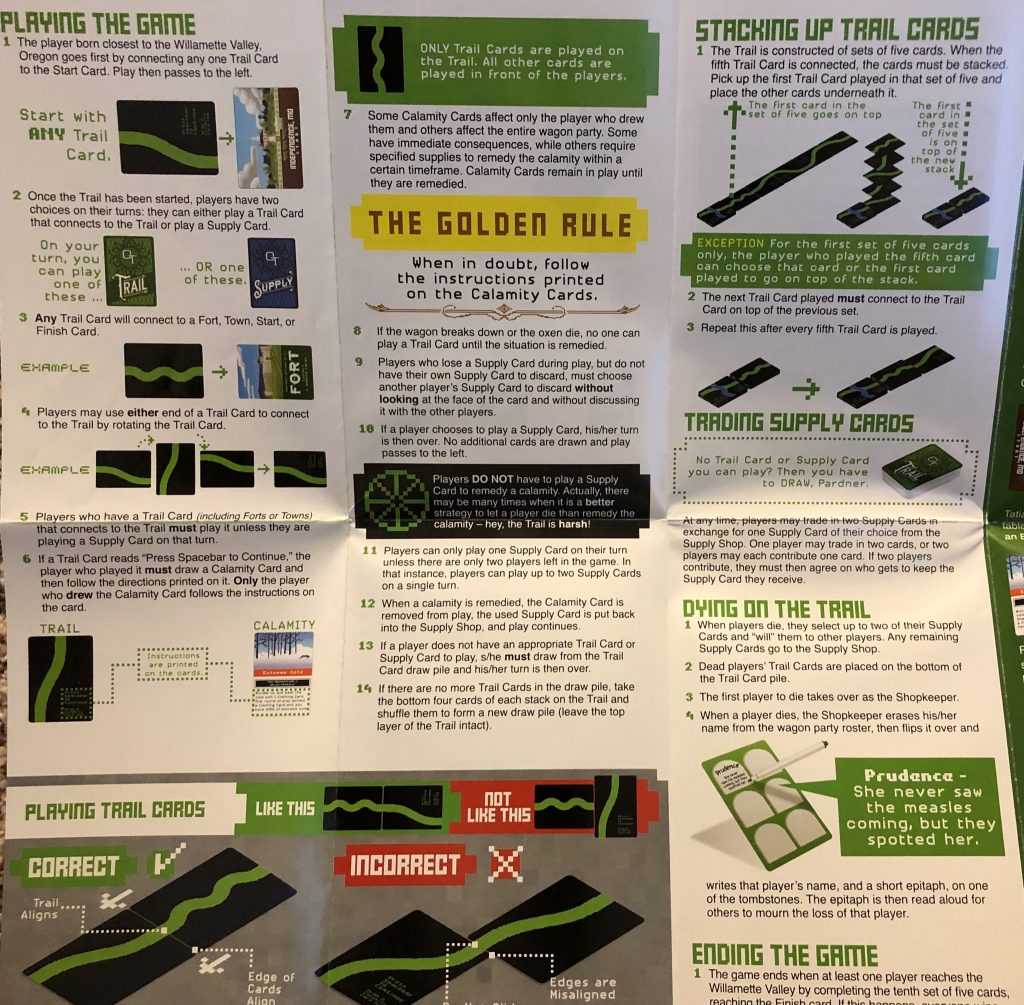
Is there such a thing as a perfect rulebook? I have yet to find one, but there are some that have come pretty close. The quality of the rules can either make or break a game – your first experience with a new game is usually through the reading of the rules! Yes, I want to get to playing the game, but I want to make sure I know how to play first. To the rulebooks that have detailed text, examples, and graphics – you da real MVP.
